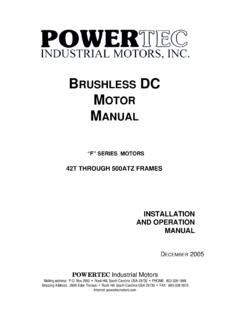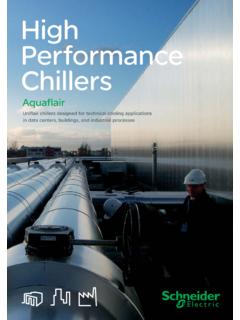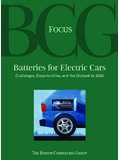Transcription of Large Brushless Drive Systems: Is there one in your …
1 Large Brushless Drive Systems: Is there one in your future? Brush DC motors have been the most prominent variable speed technology since the DC motor was invented 1 by Werner Von Siemens in the late 1800s. It revolutionized variable speed control of industrial machines. The AC induction motor came much later in 1924 invented by Nicolas Tesla. In 1962 two engineers, Wilson and Trickey published a paper 2 in which they described a Brushless DC motor. Magnet and power switching device technology prevented this invention from becoming a practical general purpose Drive technology until the late 1980s when Powertec Industrial Corporation started manufacturing general purpose Brushless systems at prices competitive with brush DC systems.
2 AC drives were beginning to see widespread use during this time as well, since power bridge technology was allowing inverter drives to make AC induction systems a practical alternative to DC in some applications. AC inverters did not provide good torque control or smooth speed control, however, and could not be used in many applications. By 1993, AC inverters developed into vector technology that gave the vector inverter the ability to use an AC. induction motor to provide independent torque and speed control similar to DC and Brushless DC, but using an AC induction motor. A war has been raging ever since between the three technologies, a war that has benefited the industrial consumer.
3 The prices of DC systems has remained at 1980. levels in spite of inflation while the price of Brushless and AC vector systems has dropped to the point that all three technologies are close to the same pricing (with exceptions being at the size extremes). Brush DC systems have reached the pinnacle of their design, with better motors, brushes, frame configurations, and drives with software control providing the best possible performance and reliability. AC induction motor systems have advanced to solving most of the standard induction motor problems running on the most modern AC vector Drive designs with high speed IGBTs (Insulated Gate Bipolar Transistors) and advanced control algorithms.
4 Brushless Drive systems have also gained ground with better magnets and much improved Drive controls. 3. Today's Brushless Drive systems include motors made with the robust 3rd generation Neodymium-Iron-Boron magnet materials that have much better thermal characteristics and high magnetic strength. With today's corona- resistance magnet wire insulation and these improved magnets and the exceptional performance of a modern Brushless Drive , the industrial consumer has available a Drive system capable of the roughest application that will also provide high accuracy performance at competitive prices. Applications where Brushless drives are being used today include those not typically requiring very high performance drives, but requiring tough, dependable, continuous duty operation.
5 A significant number of applications on extruders, wire drawers, winders, cranes, cable tensioners, conveyors, pullers, printing presses, roll formers, and other traditional tough applications are being done with Brushless drives from the major Drive system manufacturers. Why Brushless ? What is the reason machinery manufacturers and users choose Brushless over the time-proven DC Drive or the now widely accepted vector induction Drive /motor systems? 1. Performance: Brushless systems offer the highest available dynamic accuracy of any of the three major types of Drive systems. Dynamic accuracy results in consistent and repeatable machine performance creating less product variation resulting in higher quality product and higher production rates.
6 Extensive tests were performed on a blow-molding machine of Brush DC versus Brushless and a clear advantage was shown in production performance from the Brushless Drive system . 4. 2. Size: Brushless motors are the smallest available motors for a given power rating. The small size fits the requirements for smaller machines taking up less plant floor space, and the lighter weight results in lower shipping cost, easier handling, and lighter machine structure to support the motor, which is usually a substantial part of the mass in many machines. 3. 3. Efficiency: The Brushless motor is the most efficient motor technology available today for an industrial application.
7 This means less heat to get out of the machine, less heat into the manufacturing area, and lower power consumption. Brushless system efficiencies are typically 2 to 3 percentage points higher than induction vector systems and greater than this against brush DC. 3 Formal tests were conducted by Ontario Hydro (Canada) in a before/after comparison of a machine conversion from brush DC to Brushless DC, in which efficiency improved 13% minimum, and a whopping 78% at 25% speed 7. See the following efficiency comparison table. Table of increase in efficiency of 25 hp Brushless over 25 hp Brush DC from Ontario Hydro Study 7.
8 % Base Torque, % of rated Speed 100% 75% 50% 25%. 100% Na 75% 50% 25% 10% 4. Bearing Stress: Unlike AC induction motors 6, particularly Large motors 50 or more hp, Brushless motors with surface-mounted magnets have very Large air gaps and therefore very low stator- rotor capacitive currents. Large AC motors have substantial difficulty 5 with bearing damage due to current flow from the rotor through the bearing. Additionally, both brush DC and AC. induction motors create very high heat levels in the rotor and much of this heat must be conducted through the shaft and bearings to the stator before being removed by the ambient air.
9 Brushless motors produce very little rotor heating because there is no electrical current (other than minor eddy-current loss) and no slip in the permanent magnet rotor. Advancements in magnet technology (reducing cost of magnets), combined with smaller physical size, results in today's Brushless motors being less costly to make. The proliferation of PWM type drives and improvements in manufacturing procedures and economies of scale has created a high performance Drive control that costs much less to make than in years past. This means Brushless systems do not necessarily cost more. In fact, Brushless systems may even be less costly that either of the other two primary variable-speed Drive technologies in the 20 to 200 hp range.
10 Brush DC drives still have the cost advantage in the above-200 hp range due to the simple elegance of the controller using SCRs rather than the more costly IGBTs used by both induction vector and Brushless . Motors smaller than 20. hp are made in very high volumes and the induction vector systems, as well as brush DC have the cost advantage in those smaller sizes, where the smaller Brushless motor is not enough smaller to make up for the magnet cost. Who makes Large Brushless drives today? Any induction vector Drive has the basic power system to run a Brushless motor, but Brushless motors must be shaft-position commutated and require a different control algorithm (software) than the induction motor.







